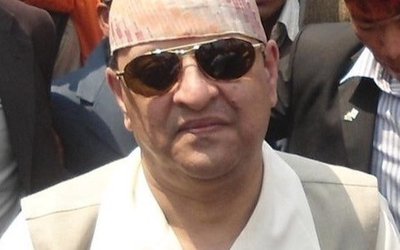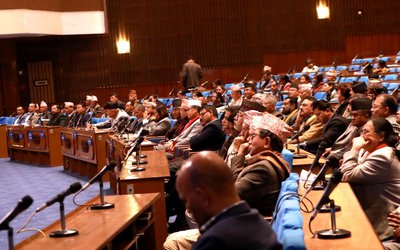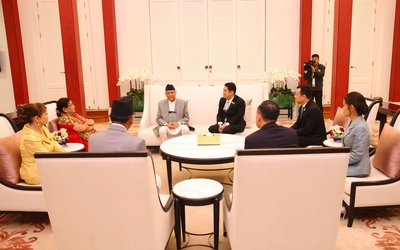
Extension of Chinese Railway to Kerung and other regions further west in Tibet would be a boon to Nepal. This railway would also be helping to boost the constantly increasing bilateral trade between India and China. Bihar and the UP would be the direct beneficiary of growing China-India trade routed through Tibet.
Trade tension between the U.S. and the rest of the world is compelling China and India to increase rapidly their bilateral trade. The Tibet railway would be one of the routes for future expansion of trade between them.
Implementation of the Tibet railway , which has already been extended upto Sigatse, had indeed been a great engineering challenge. Building a vast length of railway track on permafrost zone was the most difficult task.
For the time being excellent highway connecting our country with the nearest railhead in Tibet might be preferable to railway across the Himalayan range that would require negotiation of virtually abrupt drops of about 2 to 3 kilometers in a relatively short north-south stretch.
Improving Indo-China Relation
India's celebrated politician Dr. S. Swamy has written that despite being neighbours and having flourishing economies over centuries, India and China until 1962 neither ever went to war, nor took advantage of local civil wars. This is a most extraordinary and unparalleled experience of neighbourly peace in world civilisational history. The two peoples traded goods, exchanged visitors, borrowed ideas, and generally respected each other at the ruler and ruled levels — until foreign invasions and imperialism cut off normal interactions and relations became frozen. They were revived only in 1950, but fizzled out by 1959. War followed in 1962, for the first time in millennia.
After 1988 December, following then Indian Prime Minister Ragiv Ghandi's talks with Deng Xiaoping the Sino-Indian relation started to improve.
Growth of India's Trade with China
According to data of India's Ministry of Commerce in the year ended March 2018 the exports to China surged 31%, which is second highest annual pace of growth in more than a decade.
“China is more willing to give market access to India than ever before,” a spokes person for the Ministry of Commerce has said, pointing to increased access for products such as rice, fruits and vegetables, with potential for greater exports of pharmaceuticals and automobile components to China.
On the other hand, India’s exports to the U.S. could lose momentum. President Donald Trump has criticized India for its tariffs on U.S. products, and withdrew trade concessions on $6.3 billion of Indian goods on June 1. India responded with higher tariffs on about 30 American products.
India’s relative immunity from trade tensions could be coming to an end. Exports plunged 9.7% in June from a year ago, the biggest decline in more than three years.
Isolation of Bihar and UP
Chief Minister Nitish Kumar has been saying in various forums that unlike developed coastal states, Bihar is unable to achieve maximum success in all round development of the province because it is landlocked and it can not have direct access to foreign countries for trade. The Tibet railway routed through Nepal would be helping Bihar and UP to establish direct contact with several countries in central and northern Asia for trading that would enable these states to catch up with other developed coastal states.
Biggest Engineering Challenge
The three main challenges China faced in the Tibet railway construction are: engineering solution for stabilization of widespread permafrost earth, high altitude sickness and eco-environment protection. Solving the engineering problems related to construction in permafrost zone was the biggest challenge.
Permafrost earth is very sensitive to temperature changes for it melts and shrinks in volume in summer when temperature rises, but freezes with cubical expansion in low temperature of winter. There are huge areas of permafrost earth zone along the route of the Tibet Railway. Permafrost earth is extremely unstable to make track laying on it. About 550 kilometers long rail track was needed to be built on continuous permafrost zone.
Train-Bridge System
Chinese scientists have adopted special measures to control the effect of temperature on frozen earth ground. Train-bridge system has been the most peculiar one. Many long bridges were built to replace the roadbed for laying railway tracks. Plenty of radiators were installed under the bridges to block direct heat delivery to frozen earth ground caused by friction of rail track and carriage wheel. There are 675 bridges with 159.88 kilometers length along the Tibet Railway in total between Lhasa and Golmud . Among them, Qingshui River Bridge is the most famous and longest symbolic project with length of 11.7 kilometers.
Liquid Ammonia Filter
Countless hot-bars are equipped on roadsides, making Tibet Railway special scenery. Hot bar is a kind of efficient heat conduction device, made of carbon seamless steel tube. 5 meter of the hot bar is buried under ground while 2 meters of it outcrops. Some liquid ammonia is filled into the bar. The liquid ammonia, which has lower boiling point, evaporates to the top parts to cool the soil and keep them in frozen state. Insulation boards were put into use in some low temperature sections to slow down permafrost melting.
It is reported that for conducting above mentioned innovative methods, the Frozen Earth Research Base under Tibet Railway is the biggest in China and even in the world.

Dr. A.B. Thapa
Thapa writes on water resources issue
- Dudhkosi Multipurpose Project
- Jul 11, 2022
- Dudh-Kosi Power Project And Kosi Treaty
- Sep 27, 2021
- Uttarakhand Glaciers And Recent Disaster: A Lesson To Our Country
- Mar 02, 2021
- Multipurpose Langtang After Melamchi: Inter-Basin Water Transfer
- Nov 04, 2020
- Large Storage Dams Projects Wary of Giving Away Children’s Inheritance
- Dec 22, 2019















